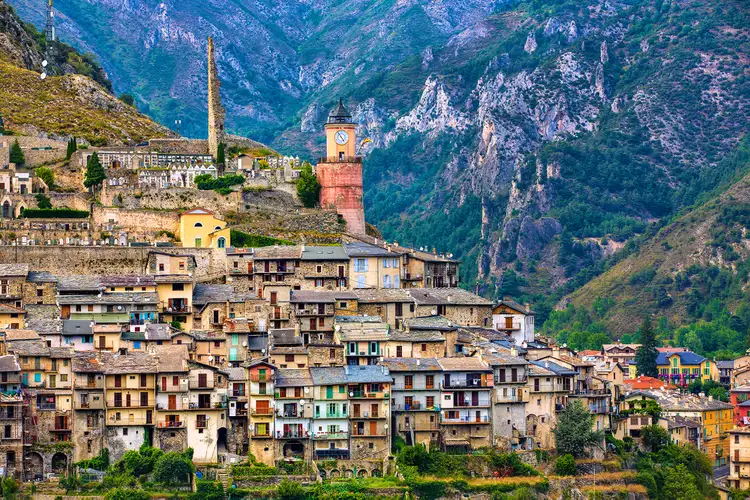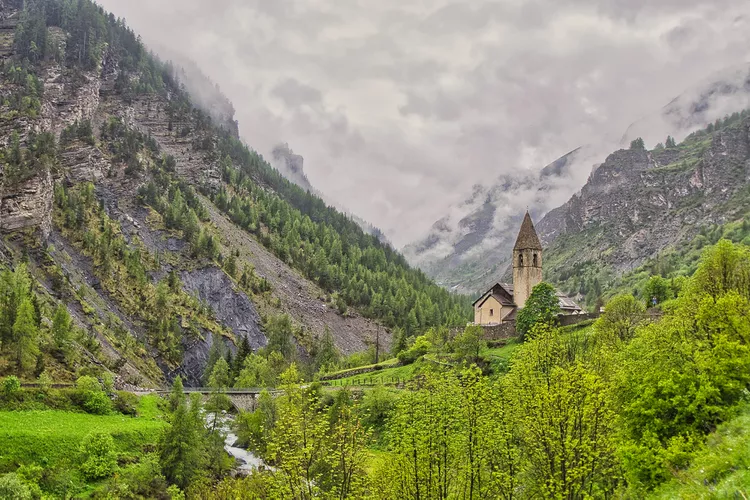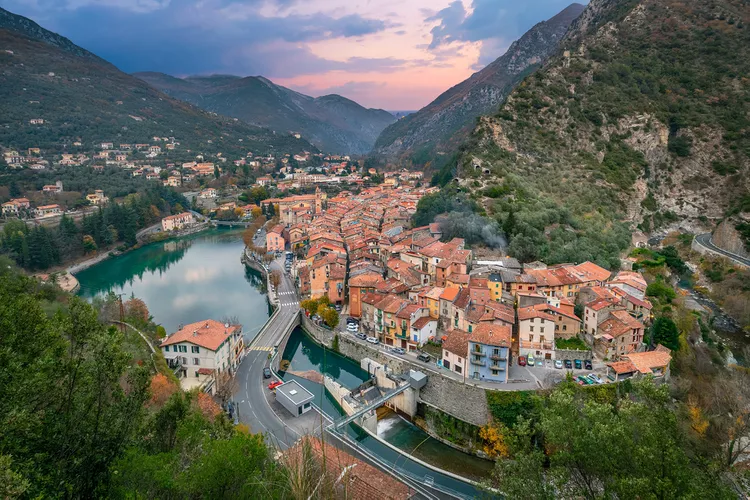The name of this train, which literally translates to "train of wonders," says it all: the Train des Merveilles.
As a redhead who can't stand being in the sun for more than an hour at a time (and as someone who has been vacationing on the Cote d'Azur for the past 20 years), I have become an expert at getting "off beach." I have walked through a number of the region's manicured gardens and shady hilltop villages, in addition to spending many hours in the region's world-class museums and hotel spas. However, taking a ride on the Train des Merveilles, which is a scheduled rail service between Nice and Tende, a mediaeval village located 2,600 feet above sea level in the Mercantour National Park, is my favourite way to fight the heat while vacationing on the French Riviera.

In the middle is a string of mountain villages that are hemmed in by the elbow turns along roiling rivers. Here, visitors can experience outdoor adventure, fresco-filled churches, history museums, a national park, and even a breed of resident sheep. All of these attractions can be found less than 80 kilometres (50 miles) from the Baies des Anges beach clubs, which is a fabled stretch of French Mediterranean coastline.

Travelling on the Magical Mystery Train
The name of this train, which literally translates to "train of wonders," says it all: the Train des Merveilles. In spite of the fact that it derives its name from the revered Vallée des Merveilles (The Valley of Wonders), a lake-filled wilderness area located within Mercantour National Park, the route does, in fact, reveal new wonders with each passing mile. As the trains with air conditioning pull out from the Nice-Ville station, the train tracks continue along the valleys of the Roya and Bévéra on their journey to the Italian border. A ride on the Train des Merveilles can be as simple as a day trip from Nice or as challenging as a weeklong adventure into one of the most breathtaking natural settings along the French Riviera, depending on the amount of time you have at your disposal and the level of physical fitness you possess.
The 9:08 a.m. train offers a French-English speaking guide between June and September for guests who want a little more at no additional cost. This guide points out gravity-defying structures and regales travellers with facts about the construction achievements that made this route an engineering wonder of its day. The guide is available between June and September. Work on the tracks didn't start until 1883, and it wasn't until 1928 that the first train carried paying customers. The railway rumbles and grumbles as it travels across hundreds of bridges, viaducts, and retaining walls. It then rumbles and grumbles as it travels through dozens of tunnels carved out of craggy rock walls.
I slid into a seat on the opposite side of the aisle from a couple who appeared to be planning a walk. They had a map laid out on the table between them and hiking poles dangling from their packs. Within the first half an hour after we had left the station, we had already started pointing and taking pictures.
The female voice could be heard saying, "I don't know where to look," as the woman pressed her nose on the glass.
I responded by telling her, "Everywhere!"
It was nearly impossible to see everything in one direction, from just one side of the train, so for the next two hours, we bounced left and right, our heads swivelling and our necks craning at the windows as we scoured steep peaks and river valleys like train-riding bobble head dolls as we passed through the landscape.

The honeycomb gold settlements and church steeples that rolled out beneath the deep ravines appeared to be inaccessible by car. Other stone homes were situated in such close proximity to the train tracks that I could make out the floral pattern on a dress that was drying on a clothesline and the lace pattern on a curtain. In a flash of technicolour, we passed by yards that were strewn with buckets and abandoned toys, as well as unkempt gardens that were ablaze in spring flowers. At one of the stops, students wearing fluorescent vests that matched each other marched in single line along the tracks. They waved in at us, and we reacted furiously by waving back with huge smiles and arm swings to match their enthusiasm. When compared to the air that had been present near the coast of the Mediterranean Sea, the air inside the train was noticeably colder and contained significantly less salt after each time the train's doors were opened and closed.
Head from Paris to Antibes by rail, skirt around Burgundy crossing the River Rhône. Just before Marseille, the fast train to Antibes follows a traditional rail route east along the Mediterranean coast towards the French Riviera. #Francebytrain https://t.co/n6SLUw19ve pic.twitter.com/HRNpotwxo2
— Rail Europe UK (@raileuropeuk) June 18, 2018
At Breil-sur-Roya, my carriage mates bade me farewell, extending their hiking poles and tying their shoes as tightly as they could. To simply be able to sit and take in the beauty while it went by felt like enough of a privilege on its own, but I could understand the desire to be a part of it.
Where to Rest and Refresh Yourself Along the Way
It would be difficult to visit all six of the communities located along the Nice-Tende route in a single day because some of the villages are located closer to the stations than others. Passengers are free to get off the vehicle at any of the stops along the route; however, they should always check the schedule before doing so, as there may be a delay of up to two hours between trains.
For this trip, I decided to make a single trip to Tende and then take it slow and steady back to Nice, stopping in La Brigue for the night along the route. My train car wasn't even close to being full; it was just myself, the couple who were hiking, and a few bikes. This will not be the case, however, during the busiest travel months of the summer and over the weekends of major holidays.
Tende might be the end of the queue for the Train des Merveilles, but it's just the beginning for serious hikers, cyclists and prehistory enthusiasts who want to explore deeper into the spectacular Mercantour National Park, which is one of France's 10 national parks. The park is home to many species of flora and wildlife that are found nowhere else on earth, as well as landscapes that are lush with alpine lakes, meadows overflowing with wildflowers, and hundreds of kilometres of paths that run beneath mountain peaks that are 9,800 feet tall and rugged gorges. The Vallée des Merveilles, also known as the Valley of Wonders, is a popular place to visit in the park because to the over 40,000 old rock carvings and paintings that can be found there. There are several regions that make the utilisation of guides and jeep tours not only possible but mandatory.
By making the short journey of five minutes from the train station to the Musée des Merveilles, I was able to avoid getting blisters while still getting a glance inside the prehistoric treasure chest of the valley. The museum contains exhibits and images that detail the rock paintings and carvings, as well as other Stone Age artefacts, unearthed in Mercantour National Park. Emilie Olivier has a charming boutique just down the road. She creates brightly coloured felt hats from the wool of Brigasque sheep, a type of sheep that is bred in the area around La Brigue.
A launch pad for intermediate and expert hikers who struggle up steep routes to adjacent villages and into Italy, La Brigue may be reached on foot from the train station by walking a level half mile to the centre of the town, which is paved with cobblestone streets. It was no problem for me to walk the three and a half miles (one way) through the forest to get to Notre Dame des Fontaines to view the frescoes that date back to the 15th century (check with the tourist office to see whether the church is open). Since La Brigue was just transferred from Italy to France in 1947, the Italian language is widely used throughout the town. In fact, I spent the night at l'Auberge Saint Martin, a humble inn and social hub where people congregate.
The restaurant is known for its "cucina bianca," a type of cooking that is based on locally grown produce and dairy from the Brigasque sheep that are bred in the area. These ingredients were transformed into the delicious potato and leek Torta Brigasque and sweet ricotta cheese panna cotta that were served to me as part of my lodging that included half-board. While out for a stroll in the wee hours of the morning, I heard what sounded like hollow bells. Following the sound, my eyes were drawn to a shepherd and two dogs who were herding a flock of Brigasque sheep straight up the slope.
Canoeing and kayaking trips for beginners as well as more expert canyoning adventures in the Roya River valley begin in Breil-sur-Roya, which is about an hour's drive from Nice. Thrill seekers looking for whitewater adventures may easily step off in Breil-sur-Roya. The Mat & Eau shop, which is located a half mile on foot from the station, is in charge of organising everything. If you would rather not get wet, you may visit the farmers market on Tuesday morning and buy for local delicacies such as olive oil and tapenade, or you can go for a stroll to the top of Cruella Tower, which is all that is left of a wall from the Middle Ages that formerly ringed the hamlet and was named for a kind of hawk and not the Disney character Cruella de Vil.
Sospel, which is roughly an hour's drive from Nice and features an easy walk to and from the train station, was once a staging area along the historic Salt Road in the Maritime Alps. The two sections of the town are connected by a fortified stone bridge that spans the Bévéra River. A major attraction in this area is the Baroque Saint-Michel church, which houses artwork from the 15th through the 17th century as well as an organ that was built in 1843. I stopped in for a quick cup of coffee at the laid-back La Vie Est Belle snack shop, which is located on the plaza. The shop's outside tables are located within walking distance of the cathedral doors. In the course of the summer, the town plays host to an entrancing baroque music festival, which takes place in a number of different locations and squares, including the cathedral.
Advice on Travel and Purchasing Tickets
The SNCF, which is the national railway company of France, is in charge of operating the Train des Merveilles, which is a regular service that runs between Nice and Tende and has five departures each day. It's fine to get on and off at different stops, but each ticket is only valid for one date and one route. There is a bus that leaves Nice-Ville at 5:45 in the morning and arrives in Tende at 8:26 in the morning. This bus is ideal for early birds or for people who want to beat the summer throng.
The price of the ticket for each direction is just about 15 euros. On the other hand, the Pass Touristique, which will be available between May 26 and September 30, 2023, is a better deal. It is only €16 for the first traveller to use it for an entire day of travel inside the department, and €10 for up to eight additional travellers after that.
There are no seats that are reserved for passengers on the Train of Wonders, however it is common knowledge that window seats are the most desirable.
You won't come across a bar or snack car either. It is, however, acceptable for you to carry aboard your own beverage. I made a pit stop at Paul, a bakery that is located just outside of the Nice-Ville station and opens at 5:30 in the morning. They serve freshly baked croissants and coffee, as well as sandwiches, cheesy baked goods, and sweets to keep you going throughout the day.
Even while trains are typically quite punctual, you should still check the timetable ahead of time because it can alter minute by minute.

